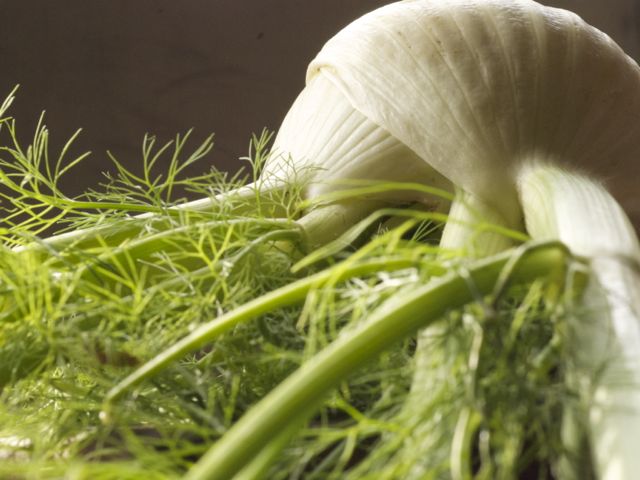
reference-image, l
(post, Margarett Waterbury)
[%pageBreakSettings nobreak=true] The first time I ever tasted raw fennel was, appropriately enough, in Florence, Italy, the namesake city of the plant’s most well-known varietal. Down the street from my school was a bar that served enormous lunch salads in deep white bowls: bitter greens blanketed in a thick layer of olives, oil-cured tuna, cubes of provolone, tomatoes, and thin green slices of what I thought at the time was the strangest-tasting celery I had ever had. I ate them near-daily. Only later did I realize those crisp crescents weren’t celery at all, and that there was more to fennel than those little licorice-flavored seeds my grandmother put in her biscotti. [%image reference-image float=right width=400 caption="It may not be too late to find fennel at the farmer's market."] Aristocratic, wispy, and elegantly structured, fennel is like the dancer of the winter vegetables — delicate to look at, but deceptively strong in both taste and tenacity. (In the western U.S., some varieties are even categorized as invasive.) Built like bamboo, fennel's bright green, sectioned stalks support lace-like fronds and cup-shaped umbels high above its garden neighbors. Endemic to a wide swath of the Mediterranean, Central Asia, and the Indian subcontinent, fennel is often associated with Italian cooking, but it actually appears in a diverse variety of cuisines, playing prominent roles in traditional Eastern European, Indian, and even Chinese culinary traditions. [[block(sidebar). h1.Featured recipes]] Part of the fun of fennel is its economy. From bulb to seeds, every portion of this plant is not only edible but delicious, each a distinct expression of fennel’s characteristic anise flavor. The round, crisp bulbs found in the grocery store are the result of human selection, the product of a varietal called Florence fennel or bulb fennel. Wild fennel, the source of the small brown seeds found in the spice aisle, typically lacks this bulbing habit. Instead, it puts all of its energy into developing taller and stronger stalks, fronds, and blossoms. Fennel bulbs can vary in size from petite torpedoes to large rounds the size of a grapefruit. The best bulbs are sweet, juicy, aromatic treats, crunchy and slightly numbing to the mouth in a refreshing and satisfying way. Look for firm, white, heavy bulbs, but don’t be put off by slight brown striations on the outside; those outer layers are usually rather tough and better peeled off, anyway. Sliced thinly, fennel bulb makes an outstanding addition to winter salads, especially those featuring apples, cheeses, beets, or citrus. Thicker wedges can be roasted alongside squash or turnips. And individual layers of the bulb hold their shape well enough to be stuffed or used as edible serving cup (like a crisper, more flavorful Belgian endive). Fennel is a critical vegetable for a good bagna cauda, that loving paean to the anchovy and kitchen garden. And it is not out of place in a cold chicken or tuna salad, either. The plant’s stalks can be several feet long, and though they can be stringier than the bulb, it’s a shame to throw out all that flavor. I recently got to sample a sweet and light Asian-inspired cabbage and fennel salad at a potluck, which used not only the stalks but the bulb and fronds as well. The chef Jerry Traunfeld, formerly of the Seattle-area restaurant [%amazonProductLink asin=0684839768 "The Herb Farm" newpage=true], uses dried fennel stalks to smoke fish. In a less ornate application, I’ve peeled them to remove the tough outer strings and used them in place of celery in a mirepoix. The rest of the fennel is just as useful. Fennel fronds look and behave much like dill, making them a good addition to potato salads or gravlax. Like tarragon, they match well with lighter-flavored proteins like chicken and fish — in fact, fennel has long been a traditional accompaniment to oily seafood, prized for its ability to improve digestion and cut the fattiness of fish like mackerel or salmon. Try adding them to liquid used to poach fish or chicken breasts, or the broth used to steam mussels. Fennel seeds grow in round bunches called umbels, a happy instance of botanical onomatopoeia. The dried versions are small and brown and most often found in the spice aisle at the supermarket. They can be used ground, to disperse their woody anise note throughout a dish; or whole, creating texture and bursts of strong licorice flavor. They’re a key ingredient in herbes de Provence and ubiquitous in Italian sausage, as well as many Indian curry blends. At my house, fennel seeds are mainly used to infuse sweetened vodka or neutral spirits to make a kind of homemade anisette or Pernod; they are also omnipresent in Italian baking, including pizzelle and biscotti. Fennel pollen, perhaps the most ethereal and complex expression of the herb’s flavor, is a traditional Italian ingredient currently trendy at upscale restaurants. It’s expensive to buy in stores, but easy (if time-consuming) to harvest if you live in a place with naturalized fennel. On the Atlantic's website the dedicated forager Hank Shaw recently described how to best collect and dry wild fennel pollen. Don’t overcook fennel pollen or it will lose its delicate, fennel-and-spice flavor; instead, mix it with finishing salt to season a dish at the table or quickly bake it into fast-cooking crackers. Not all fennel sold in the grocery store comes with stems and fronds intact. For complete specimens, you may need to head to your local farmer's market, where fennel can be found well into the winter, depending on your local climate. p(bio). Margarett Waterbury is an Oregon-based writer, editor, and employee at Gathering Together Farm.

reference-image, l